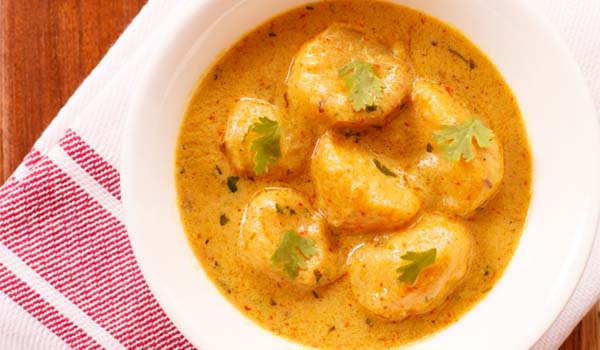Bedmi Puri is a traditional North Indian bread, particularly popular in Uttar Pradesh and Delhi. Made with a dough of wheat flour, suji (rava), and a spiced ground urad dal (black gram) mixture, this classic recipe is deep-fried until golden and crispy. Bedmi Puri is also a quintessential street food and festive meal, typically served with a potato curry and a side of tangy pickles or chutney.

About Bedmi Puri Recipe
Bedmi Puri is a distinctive fried unleavened bread from Uttar Pradesh, crafted from whole wheat flour, urad dal paste, roasted spices, and fragrant herbs. Unlike regular poori, Bedmi Puri features a rich blend of spices and herbs, imparting a unique flavor.
There are two methods to prepare Bedmi Puri: either by mixing the urad dal paste and spices directly into the flour or by stuffing cooked lentil paste into rolled dough, similar to making Urad Dal Kachori. A small amount of semolina (suji/rava) is often added to enhance crispiness, while the urad dal contributes a nutty, earthy taste.
The process of assembling, rolling, and frying Bedmi Puri is akin to preparing regular Poori or Bengali Luchi. In this recipe, the urad dal paste is combined with whole wheat flour to form the dough, making it easier than the stuffed variant. It’s important to note that this Bedmi Puri recipe differs from masala puri, which incorporates only spices into the dough without any lentil paste.
How It Is Made
To prepare Bedmi Puri, start by mixing the urad dal and spice paste with whole wheat flour. After combining the ingredients, knead the dough, divide it into small balls, and roll each ball evenly with a rolling pin before deep-frying until puffed and golden.
When incorporating ground urad dal into the flour, avoid adding water unless necessary. If needed, add water sparingly to prevent the dough from becoming overly soft or sticky. Achieving the perfect dough consistency is key for easy preparation.
Preparations include soaking the urad dal for several hours, grinding it, and roasting the spices for the mixture. This special dish is traditionally served with a spicy potato curry (aloo sabzi) and can be enjoyed as a breakfast, snack, or brunch item, though it also makes for a hearty lunch. While typically paired with a robust potato curry, it can also be served with Aloo Chole for a flavorful variation.
How to Make Bedmi Puri
Soak Urad Dal
1. Rinse ½ cup of husked and split urad dal a couple of times in water. Soak the lentils in 1½ cups of water overnight or for 4 to 5 hours. Drain all the water thoroughly and set the soaked lentils aside. Rinsing the soaked lentils again is optional, but ensure they are well-drained to prevent the dough from becoming too loose.
Roast Spices
2. Gather the following spices:
- 1 tablespoon coriander seeds
- 1 teaspoon cumin seeds
- 1 tablespoon fennel seeds
- 1 to 2 cloves
- 1 inch cinnamon stick
- 1 green cardamom
3. In a small frying pan over low heat, dry roast the spices for about 2 minutes or until they become fragrant, stirring frequently to avoid burning.
4. Add 1 teaspoon chopped ginger and ½ teaspoon chopped green chilies (or 1 green chili) and sauté for a few seconds on low heat.
5. Turn off the heat and mix in ⅛ teaspoon (or about 2 to 3 pinches) of asafoetida, 1 teaspoon red chili powder, and 1 teaspoon dried fenugreek leaves (kasuri methi) if desired.
6. Stir well and allow the spice mixture to cool to room temperature.
Make Lentil Dough
7. Place the soaked urad dal in a grinder or blender, ensuring there is no water. Add the roasted spices and herbs.
8. Add ½ cup of water and grind to a semi-fine paste, avoiding a coarse or overly fluffy texture.
9. Transfer the ground lentil paste to a large mixing bowl containing 2 cups of whole wheat flour (240 grams). Also add 1 teaspoon dried mango powder (amchur) and salt to taste.
10. Mix the ingredients with a spoon until well combined.
11. Incorporate ¼ cup fine rava or sooji and 1 tablespoon ghee or oil. Knead to form a semi-soft dough that is stiff yet pliable. Avoid adding water while kneading; if the dough appears dry, add water gradually until the right consistency is achieved. If sticky, add a little flour and knead again.
12. Cover the kneaded dough with a moist cotton napkin and let it rest for 30 minutes.
Assemble & Shape Dal Puri
13. Heat oil in a kadai or wok for deep frying. Portion the dough into lemon-sized balls and roll them between your palms for uniformity.
14. Flatten each ball with your fingers, spreading oil on both sides. Roll out each ball into a 4 to 5-inch round disc using a rolling pin.
15. You can either roll all the dough balls first and cover them with a moist cotton napkin before frying, or roll and fry the puris side by side.
Fry Bedmi Poori
16. Gently place the rolled dough into moderately hot oil. Allow the puri to puff up, gently pressing it with a slotted spoon to ensure it puffs evenly.
17. Once one side is golden, carefully flip it over and fry the other side until golden as well.
18. When the Bedmi Puri is evenly fried and golden, remove it with a slotted spoon and drain on paper towels. Avoid flipping the puris multiple times; flip them only once during frying.
19. Continue frying the remaining puris in batches, ensuring the oil remains at a moderate temperature.
Serving Suggestions
20. Serve Bedmi Puri hot or warm with your choice of potato curry. It pairs well with Chana Masala as well. These spiced puris are often served with a satvik potato curry that contains no onions or garlic. Options include Aloo Rasedar, Dum Aloo Banarasi, or Aloo Ki Sabji. Complement the meal with lemon wedges, chopped tomatoes, cucumber, and either lemon or mango pickle. Enjoy these spiced Urad Dal Puri with your evening chai.

Storage
If you cannot serve these puris hot, store them in an airtight container to enjoy later the same day. They may lose some crispiness but will still taste delightful. Refrigeration may cause the puris to become chewy or dense, so it is best to consume them on the same day.
Expert Tips
- The Perfect Dough: Knead the dough to a semi-soft texture. A hard dough will result in dry, chewy puris, while a soft dough will be difficult to roll and may lead to uneven frying.
- Spices: Adjust the quantity of ground spices to suit your taste. Roast the spices until they are fragrant but not burnt.
- Urad Dal: Use fresh lentils that are within their shelf life. Grind the soaked dal to a semi-fine consistency, avoiding both coarse and overly fluffy textures.
- Resting Dough: Allow the dough to rest for at least 20 to 30 minutes to help with even rolling and puffing during frying.
- Oil Temperature: Maintain medium hot oil for frying. If the oil is too warm, the puris will become soggy; if too hot, they may brown quickly while remaining undercooked inside.
- Scaling: This Bedmi Puri recipe can be adjusted to serve small or large groups.
Bedmi Puri & Braj Cuisine
Bedmi Puri is often prepared without onions and garlic, making it a staple in Braj cuisine, which is renowned for its satvik dishes. Braj, encompassing regions in North India, is closely associated with the legends of Lord Krishna and Radha.
Key features of this regional cuisine include:
- Focus on simple, wholesome, and flavorful dishes made with fresh, local ingredients.
- Extensive use of dairy products like ghee, butter, curd, and milk.
- Use of spices such as hing (asafoetida), fennel seeds, cloves, tej patta, cinnamon, cumin, and black pepper to enhance flavor without overpowering the dish.
Other popular dishes from Braj cuisine include Mathura Peda, Dubki Wale Aloo, Hing Kachori, Petha, and Vrindavani Arbi.
FAQs
Bedmi Poori is also referred to as Urad Dal Puri, highlighting its unique filling or dough made with urad dal (black gram lentils).
The primary difference lies in the flavoring; Bedmi Puri is enriched with ground urad dal, roasted spices, and herbs, resulting in a more textured and flavorful bread compared to the plain unleavened regular poori made solely with wheat flour and salt. Additionally, Bedmi Puri can be either stuffed with lentil filling or mixed into the dough, both variations offering a nutty and spicy taste.
Bedmi Puri is a traditional dish originating from Uttar Pradesh and Delhi, deeply rooted in North Indian culinary traditions. It is often associated with festive occasions, temple offerings, and hearty breakfasts, reflecting the region’s love for spiced, flavorful foods, and has been a popular street food and household favorite for generations.
More Gems From The Uttar Pradesh Cuisine!





